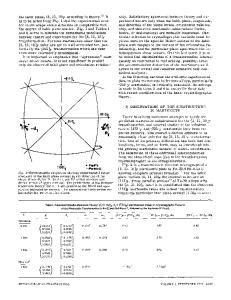Structure of martensites in Fe-Ni-Ti alloys
- PDF / 495,598 Bytes
- 4 Pages / 576 x 777.6 pts Page_size
- 22 Downloads / 292 Views
The morphology, internal structure and crystal structure of martensites in three Fe - Ni6 pct Ti alloys containing 10, 20, and 25 pct by weight of nickel have been studied. The 10 and 20 pct nickel alloys transform to lath martensite with a. dislocated sub-structure, and are not tetragonal. The 25 pct nickel alloy forms martensite plates on transformation, with a substructure of dislocations and twins. This alloy is tetragonal in both twinned and dislocated regions with a cia ratio of 1.017. Electron diffraction evidence for a tetragonal phase produced by the Bain strain of Ni 3 Ti has also been obtained. The observations support the hypothesis that the tatragonality results from the formation of an ordered Ni 3 Ti phase in austenite prior to transformation to martensite.
IRON-NICKEL-TITANIUM alloys with a nickel content in the range 27 to 30 wt pct form martensite that is tetragonal in the absence of interstitial alloying additions. l '2 The tetragonality has been shown to increase linearly with titanium content l ,2 and also to increase with aging time before transformation to martensite. 4 It has been suggested that the tetragonality is only associated with the formation of twinned martensite. 2 Two major hypotheses have been proposed to account for the tetragonality. One proposes that the presence of point defects in austenite gives rise to tetragonality upon transformation to martensite 5 due to the anisotropic strain associated with the transformation. The other hypothesis suggests that the tetragonality arises from the presence of short range order in the austenite. 6 This leads to the nearest neighbor atoms in martensite originating from different atom positions in the parent austenite. One consequence of this hypothesis is that the degree of short range order would be related to the degree of tetragonality. It is very difficult to suppress the formation of ordered regions in austenite of the composition associated with tetragonal martensite 3 and the formation of such ordered regions has been shown to have a marked stabilizing effect on the austenite and to affect the martensite start temperature. 2 Aging of the austenite results in the growth of the ordered regions and it has been shown that the structure of the ordered phase after aging is Ni 3 Ti y'. 3 It is suggested that such ordered regions transform martensitically with the matrix and the effect of a Bain strain upon the ordered phase has been considered. 2 In this investigation the effect of varying nickel content while maintaining the titanium constant upon the structure and tetragonality of martensite has been examined. It was hoped that this would provide information about the relationship between martensite substructure and tetragonality.
J. A. WHITEMAN is Lecturer, Department of Metallurgy, University of Sheffield, Sheffield S 1, 3UD, United Kingdom. D. S. SARMA, formerly Research Student, Department of Metallurgy, University of Sheffield, is now Reader in Physical Metallurgy, Banaras University, India. Manuscript submitted February 22, 1973
Data Loading...










